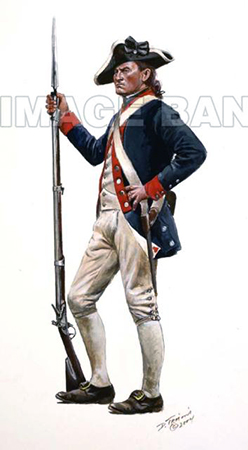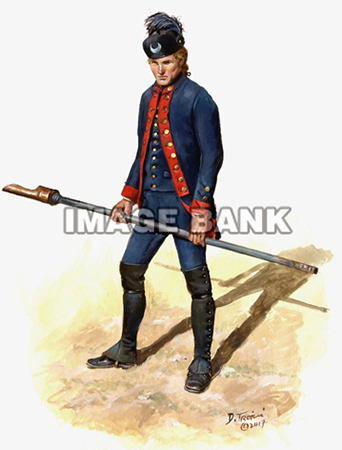 © Don Troiani Private, 3rd New York Regiment, 1777 | A Brief Profile of the Continental Army© 1999 -- 2021 - John K. Robertson and Bob McDonald SYNOPSIS |  © Don Troiani Matross, 4th South Carolina Artillery Regiment, 1776 |
This section contains several segments collectively aimed to provide the site user with a brief but comprehensive profile of the Continental Army and with an explanation of the M&R (McDonald and Robertson) numbering system used for the cataloging of the orderly books contained within the Index.
Each orderly book profiled by the Index has been assigned a unique seven-character M&R number, such as MA-01A-01, for the purpose of standardizing researchers’ and institutional referencing. Very briefly, the first two alphabetic characters designate the state, non-infantry branch of service, or other major identifier of the book. The central three characters identify the specific unit to which the book is related, while the final two characters provide for multiple books per unit. A more complete explanation of the M&R cataloging will be found within the Detailed M&R System Profile.
An initial expectation of the history of the Continental Army might be that it was a relatively uniform and consistent military force that served from 1775 through 1783. In reality, however, the nature of the army was strongly influenced by economics and by traditional perceptions of and biases against a “standing army,” this influence being strongly reflected through the decisions and actions of the army’s “employer,” the Continental Congress. For an exploration of these effects of tradition, click on this link for the Introduction section.
Although the popularized image of Washington’s army is one dominated by the service of militia “minutemen” and riflemen guerrilla forces, in reality the army command strongly desired to duplicate the professional appearance, discipline, and capabilities of an eighteenth-century European military force. Although certain organizational modifications were made to adapt for warfare within North America, the Continental Line “regulars”, indeed, were organized and functioned in a manner highly similar to the armies of Great Britain, France, Prussia, and other major contemporary European powers. A summary of the organizational development and unit formation of the army will be found within Structure & Components.
A central concept key to understanding the army’s history is that instead of the expected continuity of organization from 1775 through 1783, the army underwent a series of organizations and reorganizations at the direction of the Congress, as initially discussed in The Successive “Establishments.” With its ever present emphasis on frugality, the Congress consistently pressed for the smallest and shortest-term force possible, thereby presenting General Washington with the need for regular shifting and reorganizations in a “management by emergency” fashion. Resultantly, the wartime Continental Army actually consisted of a succession of organizations: the army of 1775 being virtually synonymous with a New England army; the army of 1776, that briefly introduced nationally-designated “Continental” battalions; the army of 1777 through 1780, which saw the number of troops expand to their greatest total; the army of 1781 through 1782, which grasped victory at Yorktown in spite of Congress’ emerging drive for reduction of troop numbers; the armies of 1783 and 1784, the force that saw the conflict through to the final withdrawal of the British garrison of New York after seven years of continuous occupation, followed by a small, interim "caretaker" force that served during the Congress' debate regarding the need for a permanent peacetime establishment for the new nation. We have also provided a special section on the Newburgh Conspiracy during which the Continental Army was urged to wrest the powers of government from the Congress.

|

|

|